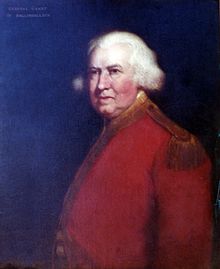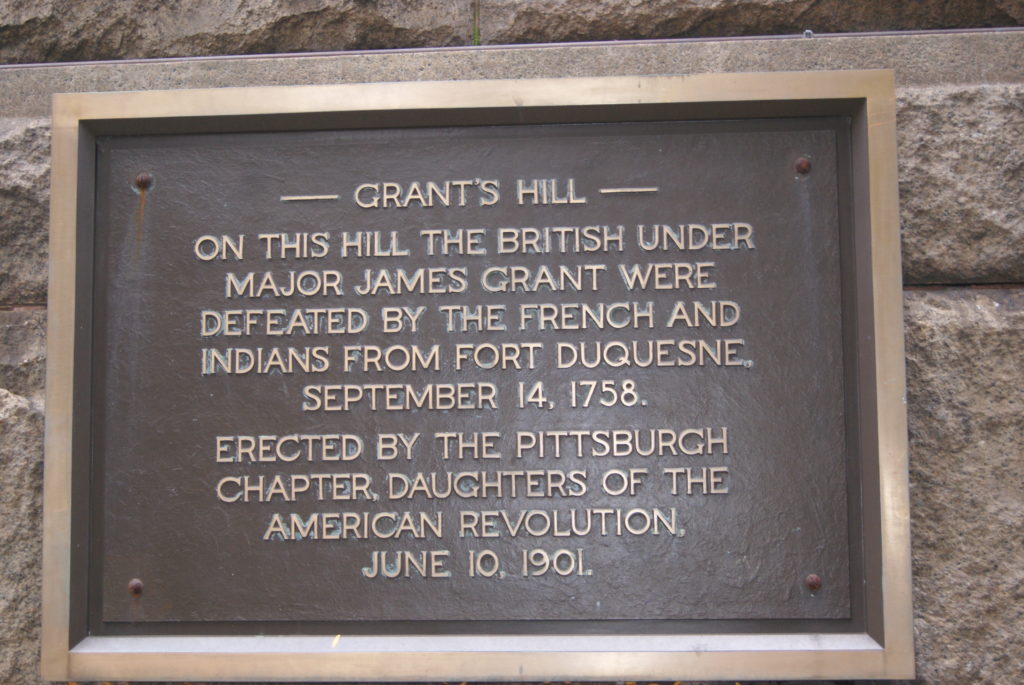Pittsburgh’s Grant Street is home to the corporate headquarters of Oxford Development, Koppers Holdings and U.S. Steel, and the seat of government for the City of Pittsburgh and the County of Allegheny. Ironically, it gets its name from the man who met his greatest defeat there.
The Forbes Expedition Begins
The disastrous 1755 Braddock expedition failed to win Fort Duquesne from the French. Undaunted, William Pitt assigned newly-appointed Brigadier General John Forbes the task of conquering Fort Duquesne in 1757.
Forbes commanded an army consisting of two thousand British regulars, twenty-five hundred Pennsylvanians, fifteen hundred Virginians, and a small number of soldiers from other colonies.
The army could have marched to Fort Duquesne on the old Braddock Road, but Forbes determined that it was too narrow and circuitous. Over the objections of George Washington, Forbes decided to build a new road through the Pennsylvania woods. They started the road at Carlisle, PA, in March 1858 and, by September, had only made it as far as Bedford. The builders predicted that they could not finish the road before winter set in.
Meanwhile, Forbes’s subordinate, Colonel Henry Bouquet was busy at Loyalhanna constructing Fort Ligonier, about forty-five miles to the west of Forbes’ headquarters at Fort Bedford. Fort Ligonier was to be the jumping-off point for the attack on Fort Duquesne.
Enter Major Grant
Constant Indian raids shook morale at the under-construction fort, and drained it of needed supplies. Bouquet proposed to send out two parties of a hundred men each to guard the paths to the fort. Enter Major James Grant, who thought he had a better idea.
Grant was thirty-seven years old at the time, Laird of Ballindalloch, and a major in the 77th Regiment of the Foot (also known as Montgomery’s Highlanders). Both Forbes and Bouquet thought highly of him. In a letter to General Forbes dated June 16, 1758, Bouquet wrote, “If you need an officer suitable for all purposes, allow me to recommend Major Grant.” And in an August 28 letter General Forbes described him in a letter of August 28 as “inferior to few.”
Grant made the point that it was foolish to send two hundred men out as sitting ducks to guard the paths into Fort Ligonier, when the real problem lay forty miles to the east, at Fort Duquesne. He suggested a reconnoitering expedition to Duquesne, with himself in the lead. Bouquet’s confidence in Grant led him to approve the idea.
Grant set out on September 9, 1858, with about 800 men: 300 Highlanders, 150 Virginia militia, 100 Royal Americans, 100 Pennsylvania militia, 100 Maryland militia and a few Indian allies.
What was the plan?
In 1758, the hill where Grant Street lies was much higher than it is today. The plan was to march to within about five miles of the fort after dark and launch a reconnoitering party at night. If the party went undiscovered, colonial Major Andrew Lewis would stay back with half of the army and the other half would advance to present-day Grant Street, about half a mile from Fort Duquesne. From there, they would surveille the fort, attack the Indians that they assumed would be camped right outside, and then retreat.
None of that went as planned.
What actually happened on Grant Street?
First, they found no Indians camped around the fort. So, Grant assumed that the Indians were in the blockhouses nearer the fort. Grant sent a force of 400 men to attack the blockhouses, only to find them empty. The force retreated back to the hill, so far undetected.
Perhaps loath to return to Ligonier without a victory, Grant assumed that the decrepit French fort must be poorly defended. He estimated that fewer than 600 troops manned it. At dawn, he had his drummers beat reveille and sent 100 Highlanders to attack the fort. About halfway down the hill, the Highlanders met 800 French and Indian fighters, who had been alerted by the reveille drums.
Grant sent more troops down the hill to the rescue of the Highlanders, but they, too, were surrounded by the enemy. Finally realizing his peril, Grant sent runners to Major Lewis’ force five miles to the rear, urgently requesting reinforcement. Meanwhile, he threw himself and the rest of his troops into the fray.
Major Lewis and his troops arrived too late, and the fighting was hard. British and American soldiers not cut down by weapons fell into the Ohio River, where many of them drowned. Grant himself refused to surrender or retreat, declaring that his heart was broken and he would “never survive the loss of this day.” Of the 800 troops who set out on September 9, over 300 were killed or captured. The rest escaped, in a disorderly retreat, to report the catastrophe.
What happened to Grant after the battle?
For several days, Grant’s fate was unknown. Finally, on September 22, he appeared on a list of the captured and wounded. Forbes, dismayed at Grant’s recklessness and the loss of so many soldiers, lamented that “my friend Grant had most certainly lost the ‘tra montane’ and by his thirst of fame brought on his own Perdition.” (‘Tra montane’ was a French term used to describe the country just beyond the Appalachian Mountains).
The French treated Grant well during his captivity, and paroled him shortly after the battle. The Highlanders who went into battle with him were not as lucky. When the British finally took over Fort Duquesne in November – without having fired a shot – they found the rotting heads of the Highlanders mounted on spikes, their kilts flapping beneath them in the autumn breeze.
Grant blamed Major Lewis for his defeat at the forks of the Ohio, and hated American colonials forever after. After his parole, he moved to the Caribbean theater of the Seven Years War and fought in the siege of Havana. He served a stint as governor of East Florida, after the British won that territory from the Spanish in the Treaty of Paris. Back on active duty for the American Revolution, he fought in Boston, Philadelphia, Long Island and the West Indies, and was known for his contempt for and mistreatment of his American adversaries.
The marker for the September 1758 skirmish is on the corner of the City-County Building in downtown Pittsburgh, at 414 Grant Street, on the southeast corner of the intersection of Grant Street and Fifth Avenue.
Sources
Lorant, Stephan. Pittsburgh, the Story of an American City. Lenox, Massachusetts: Authors Edition Inc., 1988.
Anderson, Fred. The Crucible of War. New York: Alfred A. Knopf, 2000.
The Papers of Henry Bouquet, Ed. S. K. Stevens, Donald H. Kent, and Autumn L. Leonard. Harrisburg, PA: The Pennsylvania Historical and Museum Commission, 1951.
https://en.wikipedia.org/wiki/James_Grant_(British_Army_officer,_born_1720)
https://en.wikipedia.org/wiki/Forbes_Expedition
https://www.clan-forbes.org/people/Brig.-General-John-Forbes


